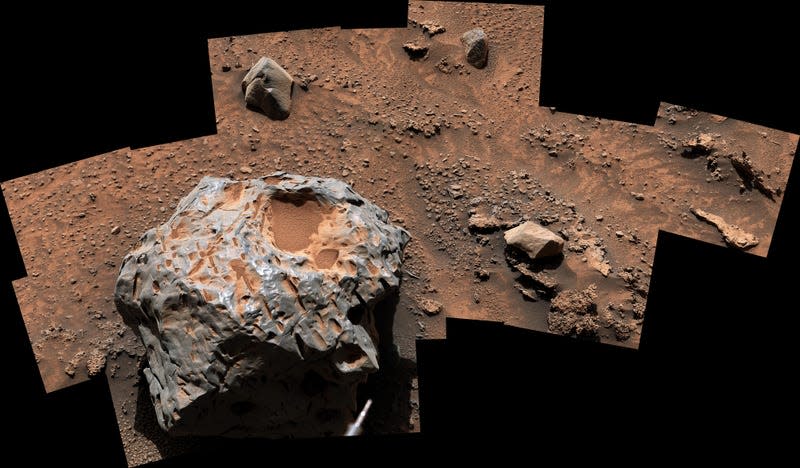Curiosity Rover Finds Foot-Long Meteorite on Martian Surface

The meteorite nicknamed Cacao on Mars.
NASA’s Curiosity rover found a meteorite as it was trucking across Mars last week.
The iron-nickel meteorite, nicknamed Cacao, is about a foot across and clearly made up of different stuff than its overwhelmingly rust-colored surroundings. The space rock was spotted by Curiosity’s Mastcam, which took 19 images of the meteorite and sent them to Earth for NASA scientists to stitch into a panorama.
Read more
These Winning Close-Up Photos Show Life That's Often Overlooked
Remembering Enterprise: The Test Shuttle That Never Flew to Space
Cacao was first spotted on January 27, in the shadow of the Curiosity rover. The next day, Curiosity repositioned itself to better image the large rock.
It’s not the first meteorite Curiosity has spotted. In 2014, the rover found an iron meteorite (nicknamed Lebanon) that measured about 6.5 feet across, and in 2016, it came across a golf ball-sized meteorite nicknamed Egg Rock on the planet’s Mount Sharp.
Iron meteorites like these regularly crop up on Earth and have caused stirs throughout human history. Japanese emperors and the pharaoh Tutankhamun had weapons forged from iron meteorites.
There’s no way to date the meteorites, the rover team said on Twitter, but the newly discovered rock “could have been here millions of years!”
Cacao was found on Curiosity’s 3,724th sol. The rover arrived on Mars in August 2012, and since then has explored the planet’s Gale Crater and Mount Sharp, a 3-mile-high mountain in the crater’s center.
Curiosity’s main mission is interrogating Mars’ ancient history and whether the frigid planet ever had the conditions to be habitable. The newer Perseverance rover is asking many of the same questions, but with a newer suite of instruments and about 2,300 miles away from Curiosity’s landing site. Together apart, the two robots are digging into Mars’ geological and hydrological past, revealing clues to an ancient world that was very different from the one we see snapshots of today.
The Perseverance rover is also collecting rock samples that will be launched to Earth in the early 2030s, making them the first pieces of another planet ever brought to Earth. The meteorites won’t be making that trip; they’re more part of NASA’s Martian sightseeing than Martian science.
More: NASA and ESA Change Plans for Ambitious Mars Sample Return Mission
More from Gizmodo
Sign up for Gizmodo's Newsletter. For the latest news, Facebook, Twitter and Instagram.

